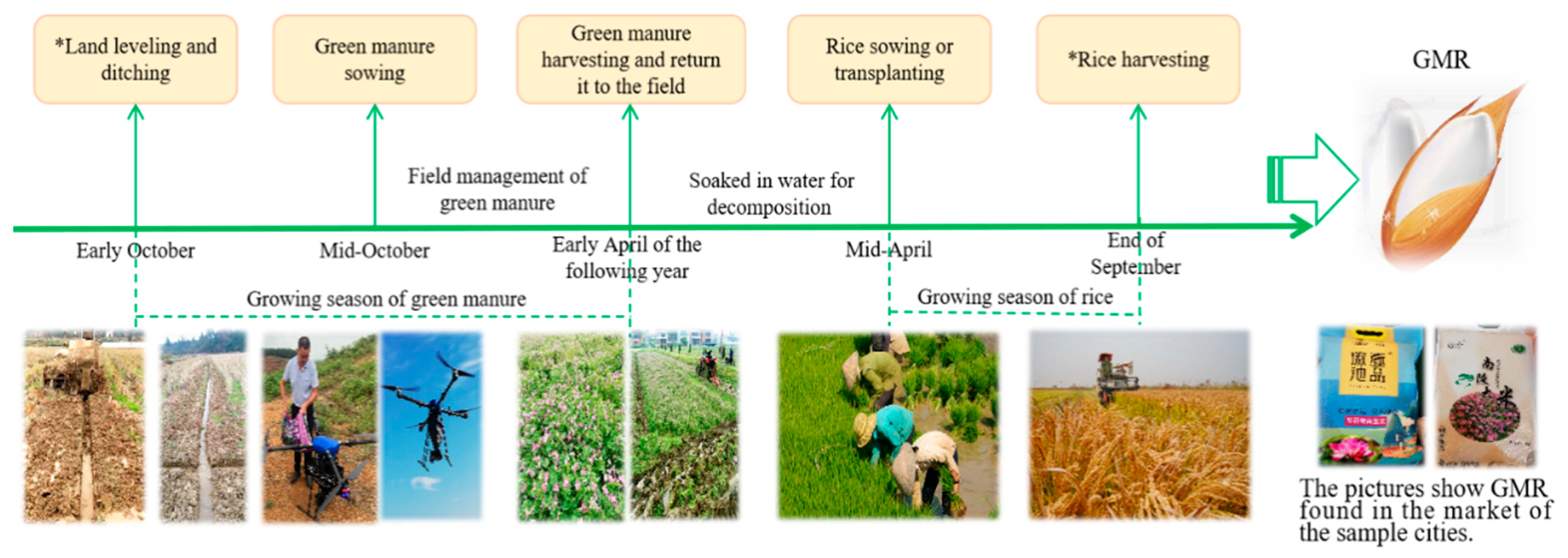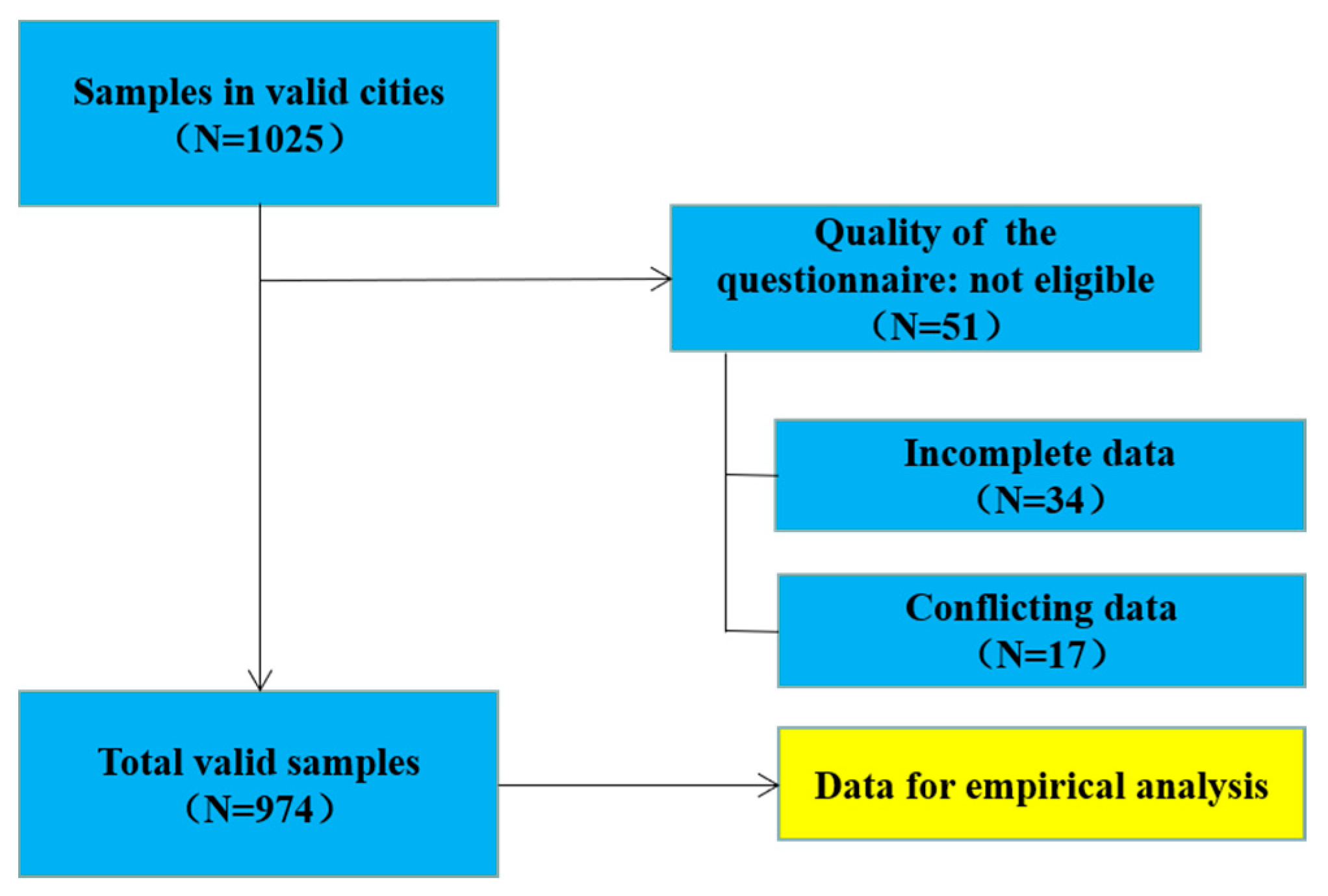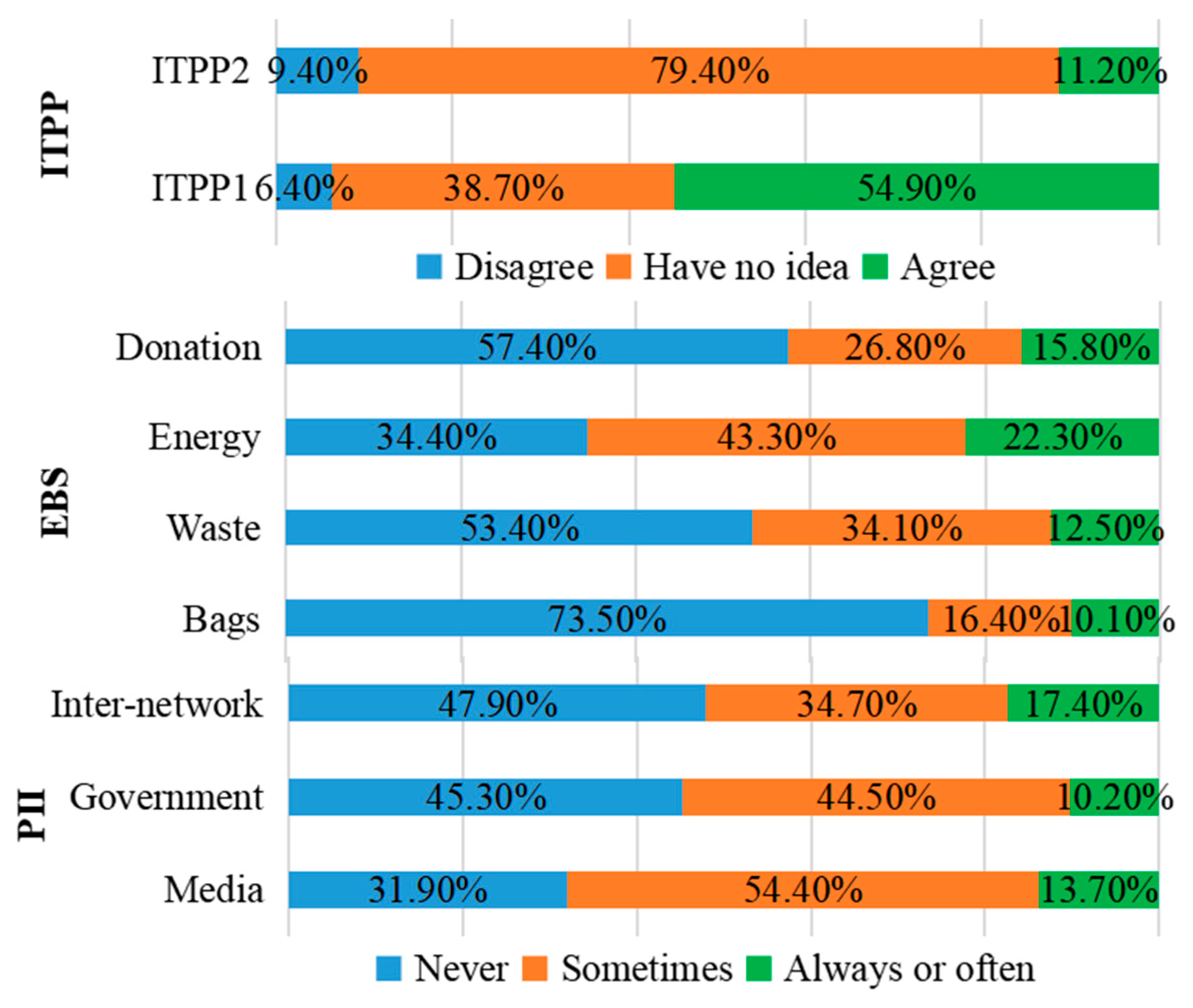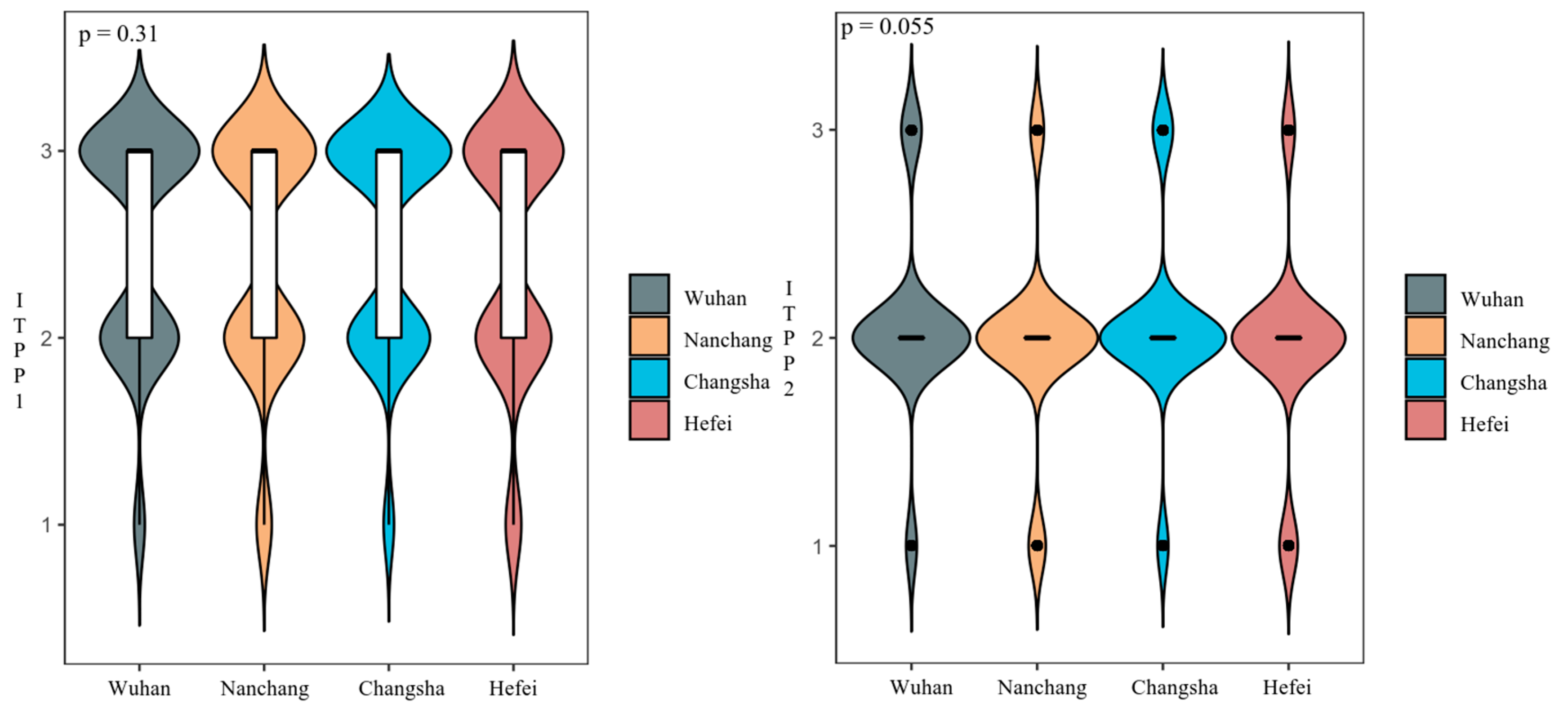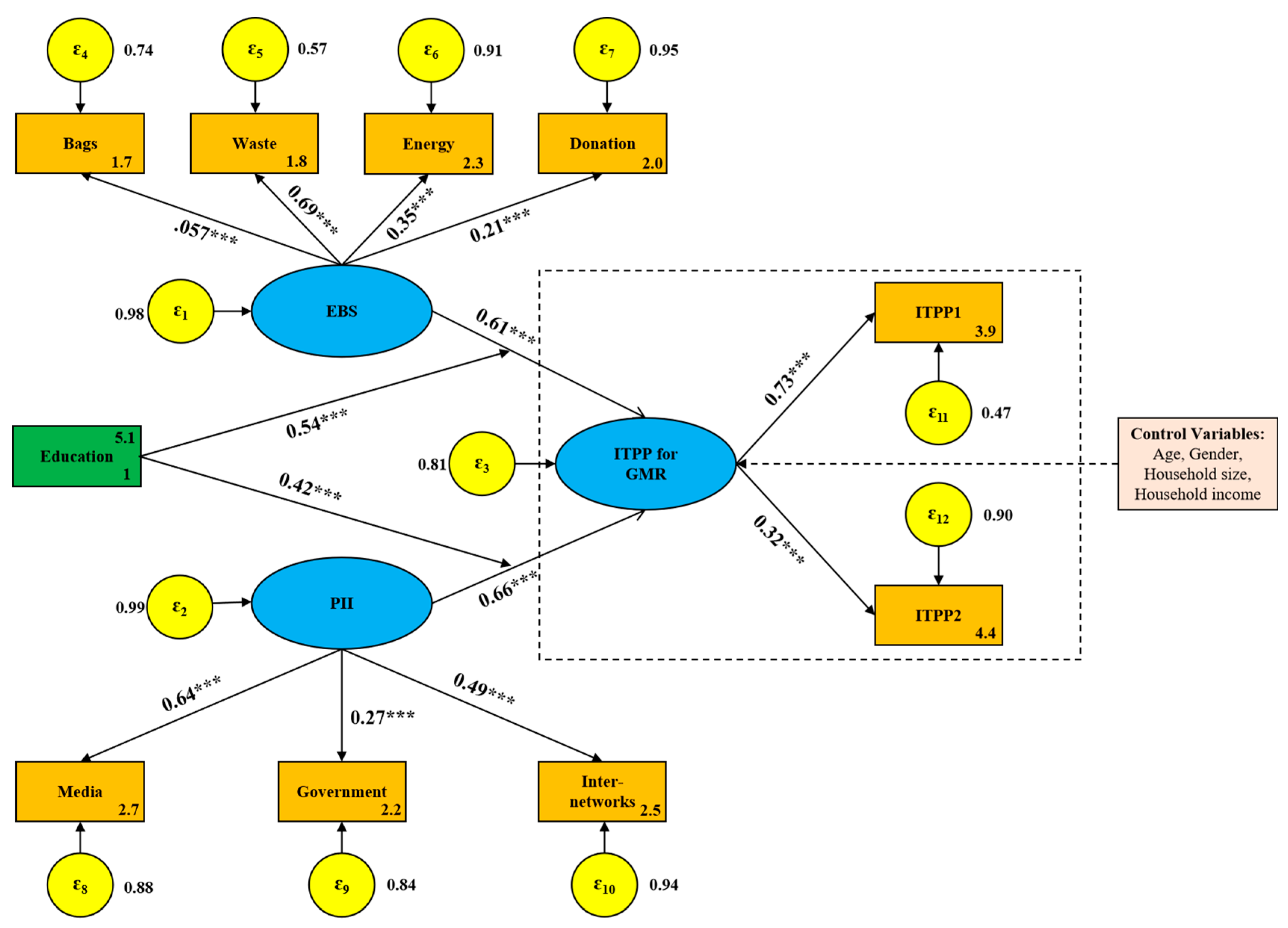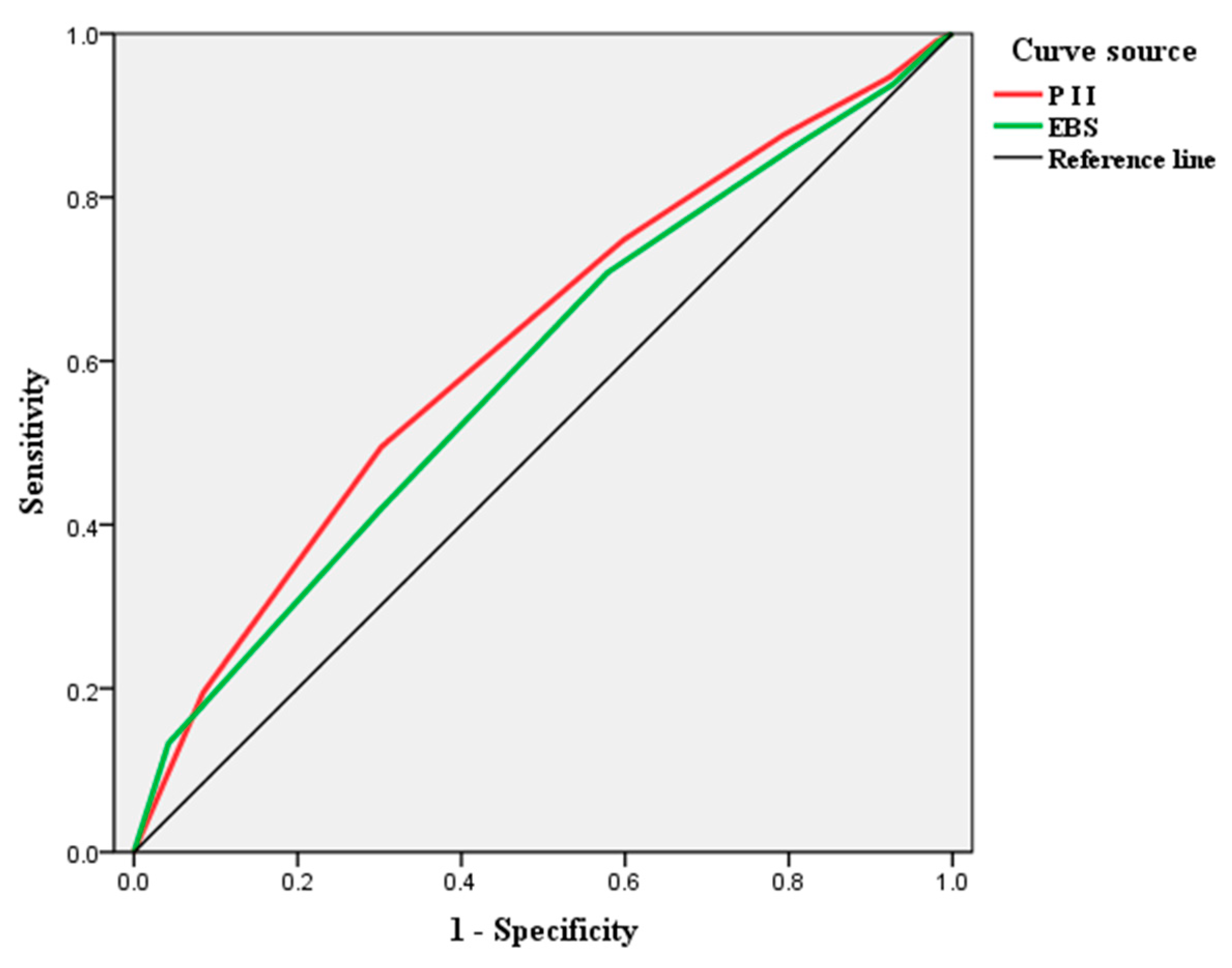1. Introduction
The use of chemicals in agriculture has strongly contributed to the increased food outputs observed over the last few decades. However, intensive inputs of these industrial synthetics have led to severe environmental consequences and widespread food safety concerns. As a response, an improved agricultural practice, green manure as substitute for chemical fertilizers, was promoted in southern China with government encouragement. Previous studies have fully explained the ecological service functions of green manure crops. They believe that green manure can not only replace chemical fertilizers to provide nutrients for crops, but also contribute to increasing soil organic matter, retarding soil erosion and passivating soil heavy metals, thus improving the total environment of the soil and the safety of agricultural products [
1,
2]. Obviously, the sustainable development and utilization of green manure is of vital importance to safeguarding the ecological security and promoting high-quality agriculture in China.
The sustainability development of green manure essentially depends on how farmers benefit from foods grown with green manure as crop fertilizer (GMFs), especially under a low government subsidy for the planting of this crop, at present. As noted by Mbwaga et al., planting green manure will make the farming system more complex and labor-intensive, which will inevitably lead to higher production costs [
3]. In this case, higher returns from GMFs are essential to stimulate producers to maintain their planting behavior. In a market economy, the income of producers is determined by the price of goods and the price of goods is closely related to consumers’ payment intentions. Although intermediaries (processors, marketers, etc.) may extract some of the value of goods in market transactions, the degree to which consumers pay is still the most pivotal aspect that determines the income of producers. Therefore, a better understanding of how consumers are paying for GMFs is crucial for both environmental policy makers and participants in the GMF industry.
Unfortunately, consumers’ payment reactions towards GMFs are currently poorly understood, which is why this study was conducted initially. Previous studies have proven that consumers are generally willing to pay premiums for pro-environmental foods (ENFs) (ENFs refer to foods produced using pro-environmental techniques or methods; GMFs belong to the category of ENFs) and that such payments tend to incentivize producers to act consistently in a pro-environmental way. For instance, Wu et al. pointed out that consumers paying a premium for environmental pork attributes can incentivize farmers to adopt cleaner production technologies in pig production [
4]. Li et al. revealed that if consumers were willing to pay a premium for environmental beef, nomads would also be more inclined to adopt climate-friendly practices [
5]. In terms of labeled rice, Yu et al. stated that consumers paying a premium for “Green rice” affect farmers’ behavioral intention to adopt environmental-friendly technologies [
6]. Zhou et al. emphasized that farmers who could benefit from the eco-labeled rice were more likely to adopt environmental behavior [
7]. GMFs provide long-term benefits to both the environment and humanity based on its emphasis on safety, nutrition and environmental friendliness. As consumers have realistic demands for products with these attributes, it is theoretically possible for them to pay premiums for GMFs. Despite the rapid development of the GMF industry over the past few years, a mature market has not yet been established. Consumers’ perceptions and purchase intentions of this product have not been clearly identified. Will consumers actually have any intention to purchase GMFs at higher price (vs. conventional foods) and what factors will ultimately influence their purchase decisions? A comprehensive understanding of these issues will help policy makers both in the agriculture and consumer sectors to make more precise policy responses.
Existing literature on consumer paying premiums for ENFs has generally paid attention to explain how observable socioeconomic characteristics influence their purchasing decisions. These influencing factors include demographic information, such as respondents’ gender, age, education level, health condition, etc. [
8], socioeconomic characteristics, such as their family size and population structure, income, dietary habit, etc. [
9], and various perceptions of the food attributes and the external environment [
10]. These variables provide simplified representations of the potential drivers involved in given contexts [
11]. However, the simplified index system is always accompanied by insufficient explanatory information, which makes it challenging to unearth the deeper incentives for consumer behavior. Under this circumstance, several research paradigms considering more meta-factors have been developed, most of which emphasized the impact of “green consumerism” [
12,
13] and “information technology” [
14,
15].
Studies conducted by de Leeuw et al. found that pro-environmental consumers are more likely to pay premiums for ENFs [
16]; meanwhile, Grunert et al. believed that consumers’ intention to pay a premium (ITPP) for the given ENF was mainly due to information intervention from public channels [
17]. Actually, consumers’ initial understanding of emerging ENFs either comes from the spillover of the green awareness that already exists with the same underlying process or from the inducible intervention of external information [
18]. Thus, the effects of environmental behavior spillover (EBS) and public information induction (PII) may be the underlying factors driving consumers to purchase ENFs, such as GMFs. Although an increasing attention has been paid to EBS and PII by scholars [
7], those studies have not empirically demonstrated the specific path of their impact on consumers’ ITPP. Moreover, the environmental awareness related to EBS and the information screening related to PII are closely associated with the education of consumers. What role does education play in the mechanisms by which EBS and PII affect ITPP? The lack of discussion on these critical topics hinders the improvement of policy makers’ awareness and the formulation of consumption policies related to GMFs.
In China, rice is the most important food crop, both in terms of production and consumption. In recent years, the Chinese government has implemented a series of supporting policies, such as subsidy policy for rice growers and minimum purchase price policy, which have achieved comprehensive support for rice farmers in multiple links and at multiple levels. According to the China Statistical Yearbook, in 2018, the proportion of rice sown area in the total coverage of grain crops of China was 30.5% and the proportion of rice yield in China’s grain output was 34.8%; both ratios are higher than those of other grain crops. Therefore, improvements in rice-based farming modes provide the broadest support for agro-environmental governance. In fact, in the last few years, the production of pro-environmental rice has been strongly supported by the government and the domestic market of these types of rice has experienced rapid development (
Table 1). Rice grown with green manure as crop fertilizer (GMR), in particular, has achieved a more significant increase in planting area and yield, compared with rice that requires professional certification, such as green rice and organic rice. China has nearly 13 million hectares of cultivated field suitable for the production of GMR and the current output of GMR is still less than 20% of the potential production capacity. If these production capacities are fully released, it will have a major impact on China’s food industry and agricultural environment. We thus decided to choose GMR as the representative of GMFs (or ENFs) to carry out this study.
The overall aim of this study is to develop a novel research framework containing EBS and PII to explore consumers’ ITPP for GMR. Specifically, this paper aims to make progress in the following two aspects: (1) To determine the path and extent of the impact of EBS and PII on consumers’ ITPP. Considering that consumers’ education can influence their environmental cognition and information identification, this factor will be included in the research framework as a moderating variable. (2) To reveal the influence mechanism of education on consumers’ ITPP. It is understood that there have been few previous studies on consumers’ ITPP for GMR and our exploration is probably one of the cutting-edge ones. The expected findings of this paper can be provided to policy makers as an opportunity to gain insight into the factors that influence consumer preferences for GMR.
The remainder of this paper is organized into five sections:
Section 2 sets up the theoretical framework and puts forward the research hypothesis. A detailed introduction to GMR is also included in this section.
Section 3 introduces the study area, survey design, data collection and research methods.
Section 4 shows the empirical results and section five discusses the main findings and puts forward the research deficiencies. The final section sums up the research conclusions.
5. Discussions and Implications
This study has enhanced the understanding of what characterizes consumers’ emerging environmental foods payment intention in China. It is among the first studies developing a conceptual model to understand how EBS and PII, together with the moderating effects of education, work together in determining consumers’ ITPP for GMR. Therefore, the findings will be valuable for policy makers who are promoting sustainable consumption of this product in their effort to improve the welfare of consumers. In addition, producers and marketers of GMR should also consider the findings of this research while drafting more effective strategies to ensure more consumption of their product at a higher level of payment.
The findings of this study confirmed that PII is, on the whole, the most salient factor affecting consumers’ ITPP for GMR, which is consistent with some studies about consumers’ ITPP for high-quality foods in emerging markets. For example, in China, Loebnitz and Aschemann-Witzel [
65] showed that external information intervention enhanced consumers’ awareness of organic food and thus their willingness to buy. In Vietnam, Schöll et al. found that the information intervention projects significantly increased consumer interest in environmental pork [
66]. In India, Singh and Verma pointed out that public information inducement was an important factor in determining consumers’ purchase of organic food products [
67]. In Malaysia, Ahmad et al. also stated that public information reinforced consumer behavior in paying for rice attributes [
68]. The possible reason is that, in developing countries, the ENFs market emerges late and develops slowly, consumers’ understanding of this category of product is insufficient and stable consumption preference has not yet been formed. In this case, consumers’ ITPP for GMR is more likely to be influenced by external induced information.
The above result provides implications for the marketing of GMR. Since positive information effectively guide consumers to pay a premium for GMR, public inducement policies can be developed to promote the industrialization of such products. First, our findings suggested that information intervention from media advertising was the most important aspect reflecting PII. Hereby, TV, internet and other novel media tools can be used to disseminate GMR-related information to enhance consumers’ willingness to pay for GMR. The better effect of media information on inducing consumers may be related to its high exposure [
69]. In addition, media information has another feature, visibility, which can also help to promote the enhancement of consumers’ behavioral intention [
7]. This is because visual information is usually presented in words, pictures and other more trustworthy ways rather than in auditory forms, such as audio broadcasts, and is therefore more impressive, in line with the connotation implied by the Chinese proverb “Hearing is empty while seeing is believing”. Second, information intervention from interpersonal networks was considered to be another vital factor revealing PII, which provides us with the enlightenment that it is of great significance to build a trust-based interpersonal interaction mechanism to promote consumers to purchase GMR at a premium. Dirks argued that interpersonal trust is highest among acquaintances [
70]. Therefore, more attention should be paid to GMR-related information diffusion through the channels of acquaintance interaction, especially to GMR marketers. Third, we found a weak impact of direct information released by the government on PII; this does not mean that the government’s role in GMR promotion is not important. The function and effectiveness of media and interpersonal network information channels need the power of the government to guarantee. Hence, how the government can play a better role in channeling public information is an issue that needs to be considered.
Our study also found that consumers’ ITPP for GMR can be significantly affected by EBS, which provides evidence of “catalyst behaviors”. On the surface, environmental behaviors seem to have nothing to do with consumers’ intention to pay for GMR; however, this recognition ignores the fact that any environmental behavior is based on the same underlying individual ideology [
71,
72]. Purchasing and consuming ENFs is essentially an environmental behavior. The consistency of the underlying process makes it possible for it to be catalyzed by other environmental behaviors, such as sorting domestic waste, using biodegradable shopping bags, saving resources and energy and donating to environmental organizations. The spillover effect of consumers’ environmental behaviors can be generated by two mechanisms: self-identity and consistency. Self-identity derives from self-perception reinforced by initial behaviors, which leads to future behaviors appropriate to the role [
73]. Consistency is self-consistent behaviors that prevent the discomforts of cognitive dissonance and conflicting attitudes [
74]. With these mechanisms working together, environmental behaviors appropriate for consumers’ current lifestyles catalyzed their intention to pay for GMR. Actually, our survey also supports the findings that EBS exists to a certain extent. Approximately 60% of respondents with the intention of paying a premium for GMR had engaged in at least one of the environmental behaviors in the past year; consumers that perform more environmental acts have a stronger intention to pay.
One novel finding is that EBS enhanced consumers’ ITPP more effectively when the payment intention remained low instead of high, which suggests that the role of EBS should be paid more attention to in the early stage of the rollout of a certain ENF. As an emerging ENF, GMR is rarely found in the market at present and consumers universally have no clear understanding of this product, which leads to their low payment intentions. According to our survey, although nearly 55% of respondents said they would be willing to make a tentative purchase of GMR, only 11% of them have long-term payment plans that can contribute to the industrialization of GMR. This situation fits with the underlying conditions for using the EBS to improve consumer behavior. Specifically, two stimuli can be taken to enhance the effect of EBS [
21]. One is to continuously strengthen consumers’ environmental awareness and increase the intensity of their environmental behavior. Both conscious learning and compulsory education are conducive to the improvement of consumers’ environmental awareness [
45]. The second is to break through the external barriers of environmental behaviors catalyzing consumers’ ITPP for GMR, such as regulating the market supply and demand of GMR to keep a relatively stable price and ensuring that the safety and nutrition claims of GMR are consistent with the facts.
As expected, education significantly improved the impact of EBS and PII on consumers’ ITPP for GMR. Many studies have recognized the key role of education in improving consumers’ payment intention for ENFs, but little in-depth discussion has been conducted on how it works. In this study, two paths were discovered through which education plays a role. First, education enhances consumers’ environmental awareness by improving their environmental knowledge, which in turn leads to high-intensity environmental behaviors [
75,
76]. Persistent and frequent environmental behaviors ultimately “catalyze” consumers’ intention to pay for GMR. Second, education positively acts on consumers’ payment intention for GMR by increasing consumers’ information channels and their ability to discriminate effective information [
77]. Given the conditions under which EBS and PII play a role, we found that the incentives of education on consumers’ ITPP is consistently effective, regardless of the intensity of ITPP. This finding provides policy makers with the enlightenment that strengthening general education and environmental education of urban residents is of great significance for promoting consumers’ intention to pay for GMR and promoting the rapid industrialization of this emerging ENF.
It is also worth noting that the contribution of this research goes beyond the specific case discussed here. It has other important connotations for scholars and policy makers. First of all, it is one of the few literatures currently exploring the ITPP for emerging ENFs such as GMR. Second, the analytical framework and economic model of this study can be generalized to a great degree and it can be applied to other consumer intentions and behaviors. Moreover, the study results and policy implications of this paper are not only of great value to the industrialization of GMR, but may also be of a certain reference value to the formulation of agricultural environmental policies related to RGRS.
This study provided a new perspective for a comprehensive understanding of Chinese consumers’ ITPP for an emerging ENFs, GMR; however, limitations inevitably exist. On the one hand, the empirical data used in this study came from online surveys, which may be followed by problems associated with sample selectivity bias. In fact, many studies on consumer intentions or behaviors have adopted online surveys based on the most extensive sampling considerations when collecting data. They generally believe that, despite the limitations of sample targeting, selectivity bias can be controlled, as long as the sample size is big enough [
49,
78,
79]. Future surveys will continue to expand the sample size and design more optimized screening procedures to minimize the impact of survey techniques. On the other hand, the four cities examined in this study were provincial capitals in southern China with a relatively large population and a high GDP, while consumer behavior in small- and medium-sized cities was not taken into account. Obviously, people living in cities with different economic statuses have distinguished consumption habits. Therefore, it is necessary for future studies to expand the scope of investigation and pay attention to the differential comparison of consumers’ intentions or behaviors in cities of different sizes.
